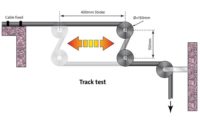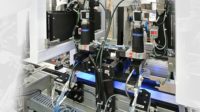
There are three critical factors in determining the right machine vision solution:
Know yourself
Know the marketplace
Know the products
Typically, individuals address the items above in the opposite priority as listed and sometimes completely leave out one or more of the items from examination altogether. This happens because many times as problems arise our tendency is to try to quickly find a solution. So, we look for a product that addresses our perceived need in the moment. By following that path, both understanding the marketplace and knowing your own capacity, limitations and complete needs are minimized or totally ignored. The danger is that the right machine vision solution, one that addresses your complete needs today and well into the future, may be totally overlooked.
By following this easy, three-step process, your selection of the right vision solution for your needs will be better assured.
Know Yourself
Let’s examine this concept of knowing oneself. This isn’t a deep philosophical exploration (although that may be enjoyable to explore over a holiday break or corporate retreat). Instead, for starters, we want to concentrate upon these important questions:What is our internal machine vision support capability? This can include such things as available development and project management resources, internal machine vision design and integration capability, experience with parts handling and presentation automation.
What are our expectations? Or another way to say it: What do we want and what do we need? You should have a pretty clear idea of what you want to achieve. Open discussion must come from all key players and there should be consensus of some kind. Expectations often turn into final requirements providing direction to the project. A failure to provide clarity will certainly come back to implementing a less-than-ideal solution and to create avoidable disharmony in your ranks. It is especially important that your organizational communication is cohesive and continuous in terms of key deliverables and the results of any implementation.
Is there project support? Issues such as funding, desire, ROI, come into play here. Who is driving this, who needs to be convinced, and who are the advocates? These are critical elements in knowing yourself as an organization.
The Machine Vision Market
Here’s the skinny on the machine vision marketplace. There are three main categories or types of machine vision companies. There are:Manufacturers – Their focus is primarily on creating or developing hardware or software. They concentrate on products and utilize a distribution channel to allow customers or systems integrators to execute actual project implementation. Typically, they aren’t directly involved in implementations and, if they are, it is typically for large projects or highly constrained ones.
Systems Integrators – Their focus is on project implementation and normally utilize either home spun products or a mix of packaged products they represent. Their capability to implement projects varies tremendously. Normally, they are limited in their organizational size, knowledge, product offerings, experience, relationships and capability. Niche capability is somewhat critical for a systems integrator in order for them to survive and to be successful over the long term. This makes them less viable for any multi-disciplinary projects.
Solution Providers – Their focus is on solutions and, typically, they have developed products internally to support their machine vision implementations. Coming from a multi-disciplinary perspective they have the internal knowledge, expertise and experience to deliver soup to nuts solutions that include automation, engineering, customization, integration, etc. Solution providers provide the best mix of a manufacturer with that of a systems integrator. As a manufacturer they have deep product expertise and as a system integrator they have on the ground experience with implementations. As a solutions provider they have extensive ability to provide integration and broad project implementation capabilities (such as systems integration, automation, product handling).
After determining what you need (Question #1) it is a great idea to drill down and determine if the companies you are looking at match up to your requirements. For example, finding a manufacturer and expecting them to work with you on a small project without any internal staffing or capability would be folly. Likewise, partnering with a systems integrator if you require process improvement, skilled design or integration expertise, would be equally unwise. However, if you have extensive in-house capabilities, buying products from a manufacturer and integrating them yourself may suite your needs just fine.
Products
Here’s a shortcut to the categories of products available for machine vision. In the vision arena there are primarily two categories:Smart Cameras – cameras and integrated software (embedded in the camera) is the primary
Intelligent Solutions – multifunctional high performance solutions that typically use open architecture
Smart Camera is a generic term that has generally come to mean a camera enabled with on-board processing. The degree of successful implementation or capability therein ranges tremendously. There is no list of features or even standards surrounding “smart cameras.” Smart cameras have had an uneven history; however, their marketing has been extremely successful. They started from the bottom-up and have been the ‘simple’ solution for such applications as bar code identification, presence/absence and product feature inspection. Smart cameras can be implemented by experienced and knowledgeable internal staff when the end result purpose is limited in scope. However, presentation of product to cameras and other functionality (lighting and reject handling) typically requires the use of a systems integrator to assist. When looking at smart cameras the tendency to underestimate the project requirements and demands will be high. It is essential to resist that tendency and to be rational in your selection of the right machine vision product. However, as long as the requirement is constrained and limited in terms of features being examined smart cameras may work.
Nonetheless, smart cameras have a multitude of downsides. These are rarely considered because the marketing of smart cameras leads customers to believe this is the best option. On the other hand, Intelligent Solutions provide an extremely solid alternative for growth, flexibility, process improvement and information distribution.
Intelligent solutions are based upon obtaining best of breed components (such as cameras, lighting, triggering and automation systems-robots, handling) combined with purpose built machine vision software and hardware. Intelligent solutions typically deliver a platform for addressing diverse needs and requirements (often in a custom or near custom fashion) in a very robust package. Of course, this can vary from vendor by vendor but overall it does hold true.
Here are a few examples of where intelligent solutions are a more appropriate choice then smart cameras:
When many smart cameras would be required to handle a job-failure to scale
Where reporting, data distribution and process analysis are important
High manufacturing speed demands
Complex inspections which can include many and diverse inspections (e.g. metrology, surface inspection), and/or difficult inspections
When there’s a need for customization, integration and/or specialized equipment
The Best Solution?
This is certainly a starting point. Secondary factors such as partner/vendor selection are better left to another discussion. Stick to getting the best solution and you will surely be far ahead of the pack: (1) Know Yourself; (2) Know The Marketplace; (3) Know the Products.Tech Tips
Ask yourself “what are my support capabilities?” and “What are my expectations?”There are three main categories or types of machine vision companies: Manufacturers, Systems Integrators and Solution Providers.
Five simple examples will let you know whether you need Intelligent Solutions or simply a Smart Camera.

